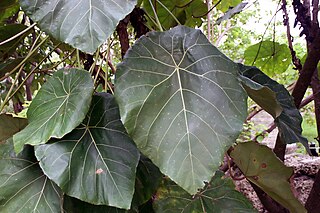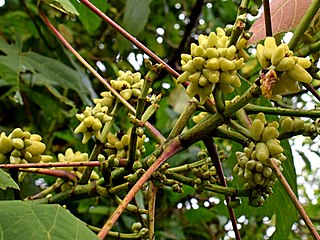
Mallotus is a genus of the spurge family Euphorbiaceae first described as a genus in 1790. Two species are found in tropical Africa and Madagascar. All the other species are found in East Asia, the Indian Subcontinent, Southeast Asia, eastern Australia, and certain islands of the western Pacific. The genus has about 150 species of dioecious trees or shrubs.

Macaranga is a large genus of Old World tropical trees of the family Euphorbiaceae and the only genus in the subtribe Macaranginae. Native to Africa, Australasia, Asia and various islands of the Indian and Pacific Oceans, the genus comprises over 300 different species. It was first described as a genus in 1806, based on specimens collected on the Island of Mauritius.

Myrmecophytes are plants that live in a mutualistic association with a colony of ants. There are over 100 different genera of myrmecophytes. These plants possess structural adaptations that provide ants with food and/or shelter. These specialized structures include domatia, food bodies, and extrafloral nectaries. In exchange for food and shelter, ants aid the myrmecophyte in pollination, seed dispersal, gathering of essential nutrients, and/or defense. Specifically, domatia adapted to ants may be called myrmecodomatia.
Cleidion is a plant genus of the family Euphorbiaceae, first described in 1826. It is found in tropical and subtropical regions in Asia, Africa, Australia, Latin America, and various islands of the Pacific and Indian Oceans.

Endospermum is a genus of plants, under the family Euphorbiaceae and the monotypic subtribe Endosperminae first described as a genus in 1861 It is native to E + S + SE Asia, Papuasia, Queensland, and certain islands of the W Pacific.
Macaranga attenuata is a species of plant in the family Euphorbiaceae. It is endemic to French Polynesia.
Macaranga bicolor is a species of plant in the family Euphorbiaceae. It is endemic to the Philippines.
Macaranga caudatifolia is a species of plant in the family Euphorbiaceae. It is endemic to the Philippines.
Macaranga congestiflora is a species of plant in the family Euphorbiaceae. It is endemic to the Philippines.
Macaranga conglomerata is a species of plant in the family Euphorbiaceae. It is found in Kenya and Tanzania. It is threatened by habitat loss.

Macaranga grandifolia is a species of flowering plant in the family Euphorbiaceae. Common names for this plant include nasturtium tree, parasol leaf tree and bingabing. It is endemic to the Philippines and has been widely cultivated in Hawaii as a tropical ornamental. This plant has become very popular garden ornamental in many parts of the tropics for the extraordinary grandiose leaves, which are rounded-ovate in shape, with prominent, reddish veins and the stem attached towards the center of the leaf blade. The flowers are pinkish red and the males are held in coral-like, congested inflorescences. Twine made from the bark and the wood was used for fishing spears. The leaves were used to wrap food. Birds eat the ripe fruit.
Macaranga mauritiana is a species of plant in the family Euphorbiaceae. It is endemic to Mauritius.
Macaranga quadricornis is a species of plant in the family Euphorbiaceae. It is a tree endemic to Peninsular Malaysia. It is threatened by habitat loss.
Macaranga raivavaeensis is a species of plant in the family Euphorbiaceae. It is endemic to French Polynesia.
Macaranga taitensis is a species of plant in the family Euphorbiaceae. It is endemic to French Polynesia.
Macaranga venosa is a species of plant in the family Euphorbiaceae. It is endemic to French Polynesia.
Macaranga peltata is a heliophyllous evergreen plant found in Western Ghats of India and Sri Lanka. A crimson colored resin called "macaranga gum" is obtained from this plant. Many parts of the plant are used for ayurvedic medicine in both countries.

Macaranga triloba is a species of plant in the family Euphorbiaceae. It is native to the tropical forests of southeastern Asia. It is a pioneer species, colonising recently cleared or burnt areas of the forest.

Macaranga denticulata is a species of Asian small trees in the family Euphorbiaceae and tribe Acalypheae, found especially in secondary tropical forests. No subspecies are listed in the Catalogue of Life and the recorded distribution includes: India, southern China, Indo-China and western Malesia.
Macaranga novoguineensis is a species of tree in the Euphorbiaceae family. It is native to New Britain and New Guinea. It is a late succession plant, and supports a variety of insect herbivores, including caterpillars from the moth Homona mermerodes.






